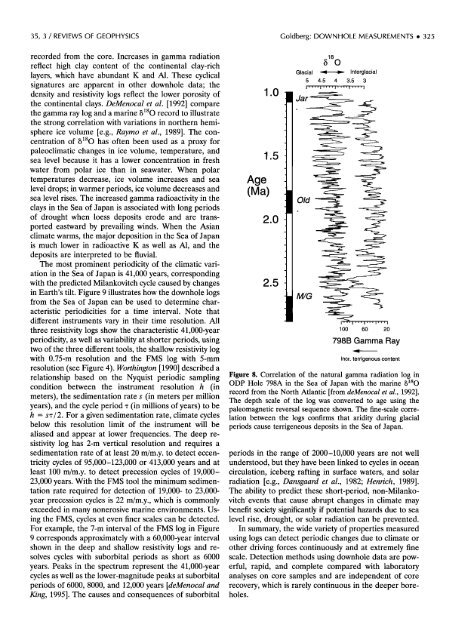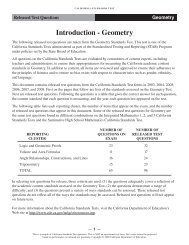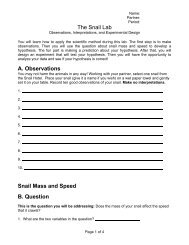The Role of Downhole Measurements in Marine Geology and ...
The Role of Downhole Measurements in Marine Geology and ...
The Role of Downhole Measurements in Marine Geology and ...
You also want an ePaper? Increase the reach of your titles
YUMPU automatically turns print PDFs into web optimized ePapers that Google loves.
35, 3 /REVIEWS OF GEOPHYSICS Goldberg: DOWNHOLE MEASUREMENTS ß 325<br />
recorded from the core. Increases <strong>in</strong> gamma radiation<br />
reflect high clay content <strong>of</strong> the cont<strong>in</strong>ental clay-rich<br />
layers, which have abundant K <strong>and</strong> A1. <strong>The</strong>se cyclical<br />
signatures are apparent <strong>in</strong> other downhole data; the<br />
density <strong>and</strong> resistivity logs reflect the lower porosity <strong>of</strong><br />
the cont<strong>in</strong>ental clays. DeMenocat et at. [1992] compare<br />
the gamma ray log <strong>and</strong> a mar<strong>in</strong>e 8SO record to illustrate<br />
the strong correlation with variations <strong>in</strong> northern hemisphere<br />
ice volume [e.g., Raytoo et at., 1989]. <strong>The</strong> concentration<br />
<strong>of</strong> 8SO has <strong>of</strong>ten been used as a proxy for<br />
paleoclimatic changes <strong>in</strong> ice volume, temperature, <strong>and</strong><br />
sea level because it has a lower concentration <strong>in</strong> fresh<br />
water from polar ice than <strong>in</strong> seawater. When polar<br />
temperatures decrease, ice volume <strong>in</strong>creases <strong>and</strong> sea<br />
level drops; <strong>in</strong> warmer periods, ice volume decreases <strong>and</strong><br />
sea level rises. <strong>The</strong> <strong>in</strong>creased gamma radioactivity <strong>in</strong> the<br />
clays <strong>in</strong> the Sea <strong>of</strong> Japan is associated with long periods<br />
Age<br />
(Ma)<br />
<strong>of</strong> drought when loess deposits erode <strong>and</strong> are transported<br />
eastward by prevail<strong>in</strong>g w<strong>in</strong>ds. When the Asian<br />
climate warms, the major deposition <strong>in</strong> the Sea <strong>of</strong> Japan<br />
is much lower <strong>in</strong> radioactive K as well as A1, <strong>and</strong> the<br />
deposits are <strong>in</strong>terpreted to be fluvial.<br />
<strong>The</strong> most prom<strong>in</strong>ent periodicity <strong>of</strong> the climatic variation<br />
<strong>in</strong> the Sea <strong>of</strong> Japan is 41,000 years, correspond<strong>in</strong>g<br />
2.0<br />
with the predicted Milankovitch cycle caused by changes<br />
<strong>in</strong> Earth's tilt. Figure 9 illustrates how the downhole logs<br />
from the Sea <strong>of</strong> Japan can be used to determ<strong>in</strong>e characteristic<br />
periodicities for a time <strong>in</strong>terval. Note that<br />
2.5<br />
different <strong>in</strong>struments vary <strong>in</strong> their time resolution. All<br />
i,-1,,, i,,, i,, ,i<br />
three resistivity logs show the characteristic 41,000-year<br />
100 60 20<br />
periodicity, as well as variability at shorter periods, us<strong>in</strong>g<br />
two <strong>of</strong> the three different tools, the shallow resistivity log<br />
798B Gamma Ray<br />
with 0.75-m resolution <strong>and</strong> the FMS log with 5-mm<br />
Incr. terrigenous content<br />
resolution (see Figure 4). Worth<strong>in</strong>gton [1990] described a<br />
relationship based on the Nyquist periodic sampl<strong>in</strong>g<br />
Figure 8. Correlation <strong>of</strong> the natural gamma radiation log <strong>in</strong><br />
ODP Hole 798A <strong>in</strong> the Sea <strong>of</strong> Japan with the mar<strong>in</strong>e sO<br />
condition between the <strong>in</strong>strument resolution h (<strong>in</strong><br />
record from the North Atlantic [from deMenocal et al., 1992].<br />
meters), the sedimentation rate s (<strong>in</strong> meters per million<br />
<strong>The</strong> depth scale <strong>of</strong> the log was converted to age us<strong>in</strong>g the<br />
years), <strong>and</strong> the cycle period -r (<strong>in</strong> millions <strong>of</strong> years) to be paleomagnetic reversal sequence shown. <strong>The</strong> f<strong>in</strong>e-scale correh<br />
= s-r/2. For a given sedimentation rate, climate cycles lation between the logs confirms that aridity dur<strong>in</strong>g glacial<br />
below this resolution limit <strong>of</strong> the <strong>in</strong>strument will be<br />
periods cause terrigeneous deposits <strong>in</strong> the Sea <strong>of</strong> Japan.<br />
aliased <strong>and</strong> appear at lower frequencies. <strong>The</strong> deep resistivity<br />
log has 2-m vertical resolution <strong>and</strong> requires a<br />
sedimentation rate <strong>of</strong> at least 20 m/m.y. to detect eccen- periods <strong>in</strong> the range <strong>of</strong> 2000-10,000 years are not well<br />
tricity cycles <strong>of</strong> 95,000-123,000 or 413,000 years <strong>and</strong> at understood, but they have been l<strong>in</strong>ked to cycles <strong>in</strong> ocean<br />
least 100 m/m.y. to detect precession cycles <strong>of</strong> 19,000- circulation, iceberg raft<strong>in</strong>g <strong>in</strong> surface waters, <strong>and</strong> solar<br />
23,000 years. With the FMS tool the m<strong>in</strong>imum sedimen- radiation [e.g., Dansgaard et al., 1982; Henrich, 1989].<br />
tation rate required for detection <strong>of</strong> 19,000- to 23,000- <strong>The</strong> ability to predict these short-period, non-Milankoyear<br />
precession cycles is 22 m/m.y., which is commonly vitch events that cause abrupt changes <strong>in</strong> climate may<br />
exceeded <strong>in</strong> many nonerosive mar<strong>in</strong>e environments. Us- benefit society significantly if potential hazards due to sea<br />
<strong>in</strong>g the FMS, cycles at even f<strong>in</strong>er scales can be detected. level rise, drought, or solar radiation can be prevented.<br />
For example, the 7-m <strong>in</strong>terval <strong>of</strong> the FMS log <strong>in</strong> Figure In summary, the wide variety <strong>of</strong> properties measured<br />
9 corresponds approximately with a 60,000-year <strong>in</strong>terval us<strong>in</strong>g logs can detect periodic changes due to climate or<br />
shown <strong>in</strong> the deep <strong>and</strong> shallow resistivity logs <strong>and</strong> re- other driv<strong>in</strong>g forces cont<strong>in</strong>uously <strong>and</strong> at extremely f<strong>in</strong>e<br />
solves cycles with suborbital periods as short as 6000 scale. Detection methods us<strong>in</strong>g downhole data are powyears.<br />
Peaks <strong>in</strong> the spectrum represent the 41,000-year erful, rapid, <strong>and</strong> complete compared with laboratory<br />
cycles as well as the lower-magnitude peaks at suborbital analyses on core samples <strong>and</strong> are <strong>in</strong>dependent <strong>of</strong> core<br />
periods <strong>of</strong> 6000, 8000, <strong>and</strong> 12,000 years [deMenocat <strong>and</strong> recovery, which is rarely cont<strong>in</strong>uous <strong>in</strong> the deeper bore-<br />
K<strong>in</strong>g, 1995]. <strong>The</strong> causes <strong>and</strong> consequences <strong>of</strong> suborbital holes.<br />
1.0<br />
1.5<br />
18<br />
Glacial Interglacial<br />
Jar<br />
5 4.5 4 3.5 3<br />
I''''1 .... I''''1''''1<br />
Old --<br />
ß
















